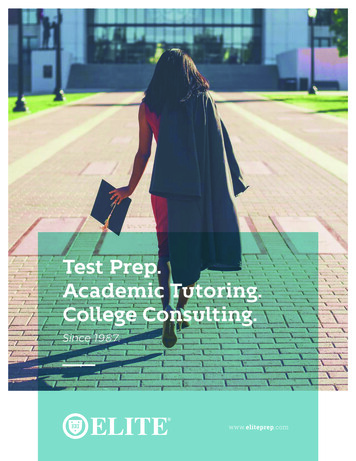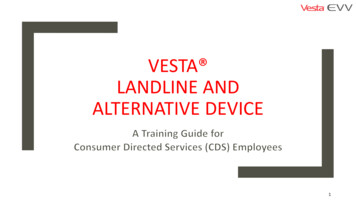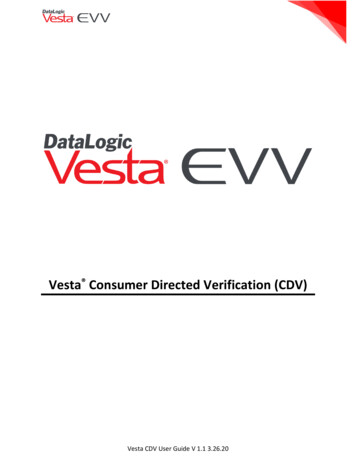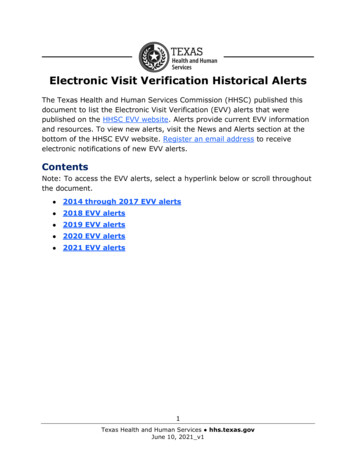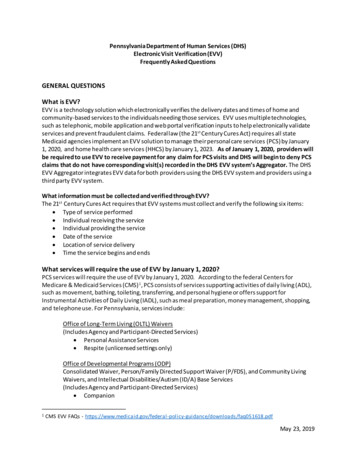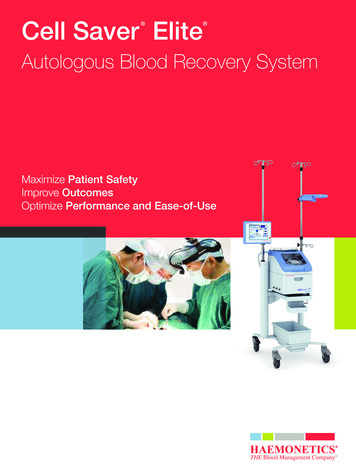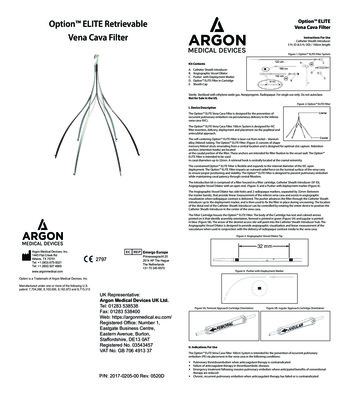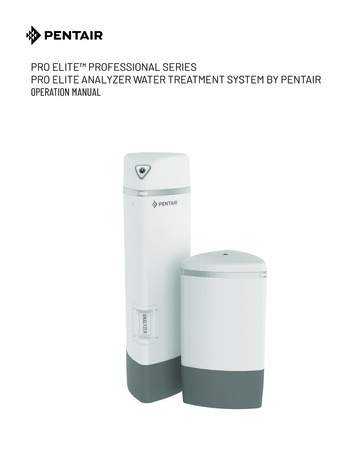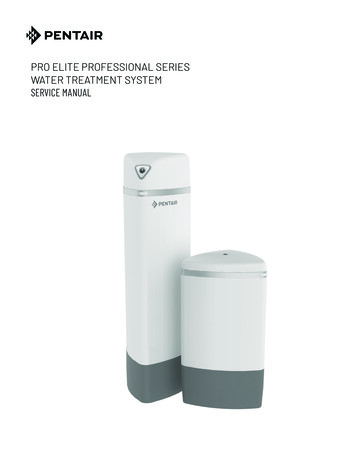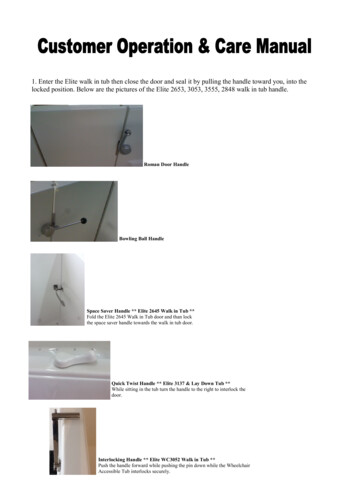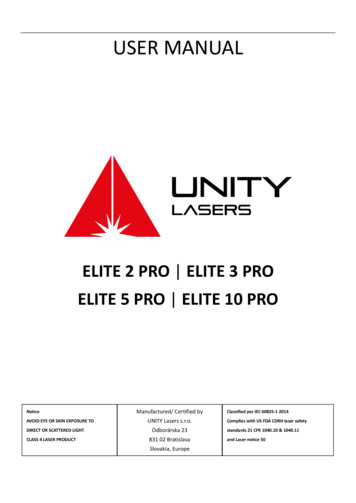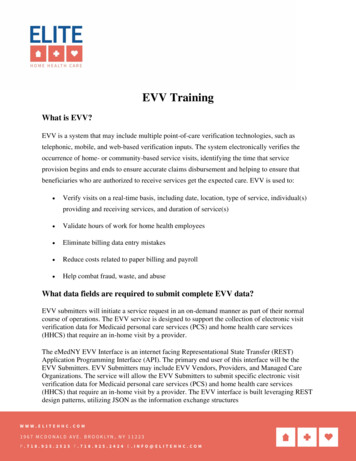
Transcription
EVV TrainingWhat is EVV?EVV is a system that may include multiple point-of-care verification technologies, such astelephonic, mobile, and web-based verification inputs. The system electronically verifies theoccurrence of home- or community-based service visits, identifying the time that serviceprovision begins and ends to ensure accurate claims disbursement and helping to ensure thatbeneficiaries who are authorized to receive services get the expected care. EVV is used to: Verify visits on a real-time basis, including date, location, type of service, individual(s)providing and receiving services, and duration of service(s) Validate hours of work for home health employees Eliminate billing data entry mistakes Reduce costs related to paper billing and payroll Help combat fraud, waste, and abuseWhat data fields are required to submit complete EVV data?EVV submitters will initiate a service request in an on-demand manner as part of their normalcourse of operations. The EVV service is designed to support the collection of electronic visitverification data for Medicaid personal care services (PCS) and home health care services(HHCS) that require an in-home visit by a provider.The eMedNY EVV Interface is an internet facing Representational State Transfer (REST)Application Programming Interface (API). The primary end user of this interface will be theEVV Submitters. EVV Submitters may include EVV Vendors, Providers, and Managed CareOrganizations. The service will allow the EVV Submitters to submit specific electronic visitverification data for Medicaid personal care services (PCS) and home health care services(HHCS) that require an in-home visit by a provider. The EVV interface is built leveraging RESTdesign patterns, utilizing JSON as the information exchange structures
21st Century Cures Act Requirements and Start Date for EVV for PCSServicesThe 21st Century Cures Act, is a federal law, passed by Congress in December 2016, that in partrequires all state Medicaid programs to implement an EVV system for personal care services(PCS) and home health care services (HHCS). All states must implement an EVV system toavoid a reduction in federal Medicaid funding. The Cures Act includes a provision that allowsfor the delay of implementation for up to one year if a state has encountered unavoidable delays,as demonstrated in a good faith effort (GFE). On December 5, 2019, the New York StateDepartment of Health s EVV GFE exemption request was approved by the Centers for Medicareand Medicaid Services (CMS).As such, the New York State Department of Health (NYSDOH) required providers of Medicaidfunded PCS to select and implement EVV systems that meet the requirements of the 21stCentury Cures Act by January 1, 2021. Providers of Medicaid-funded HHCS will be required toselect and implement compliant EVV systems by January 1, 2023.For more information on thefederal law and requirements for EVV, visit:Medicaid.govServices that require EVV data collection:The following list provides the programs affected by the implementation of EVV for PCS andHHCS. 1905(a)(24) State Plan Personal Care BenefitoConsumer Directed Personal Assistance (CDPA)oPersonal Care Assistance (PCAI & II)
1915(c) Home and Community Based Services waiversoChildrens WaiveroNursing Home Transition and Diversion (NHTD)oTraumatic Brain Injury (TBI)oOffice for People with Developmental Disabilities (OPWDD) comprehensive1115 DemonstrationoCDPAoPCAI & II
Training for Caregivers Provider s System Overview and Workflows (non-technical)Elite Choice has chosen HHAeXchange as the Database used to collect EVV information.In the next few pages, you can learn how to properly use HHA exchange when recordingyour time and attendance via their EVV systemHHAeXchange is the premiere Homecare Management Software company. They are theleaders in connecting payers and homecare agency providers to enable morecollaboration, communication, and workflow efficiencies. How to electronically collect EVV data using the Providers system anddevice(s)New York State, along with guidance from the Centers for Medicare and MedicaidServices (CMS), the following technologies are compliant methods for collectingElectronic Visit Verification (EVV) data: Telephony: Telephone calls can be used to capture service period and verifylocation. Typically captured with a landline telephone. Mobile App: Apps can be downloaded and used to capture service period andverify location. This option allows the worker to record visits using a smart phoneor tablet, even when no cellular, satellite, or other data services are available atthe service location. Fixed Object (FOB): In-home Fixed Object devices with a unique ID verifylocation.
How to and when to collect EVV data manually and what to documentAll EVV services are required to have complete EVV data in order to be considered averified visit. In the circumstance that a visit was not electronically captured at the timeof the visit, the provider agency or Fiscal Intermediary (FI) may manually enter the visitinformation. Manually entered visits should only be used when absolutely necessary. Theprovider agency or FI must retain and maintain documentation of the reason for themanual entry. The Office of the Medicaid Inspector General (OMIG) or the NYSDOHwill audit and monitor the use of manual or paper timesheets. It is the responsibility ofthe provider agency and/or Fiscal Intermediary (FI) to ensure that an earnest effort ismade to capture EVV through a compliant method. Religious holidays or observancesthat impact the use of technology use in capturing EVV in a compliant manner count as amanual entry. NYSDOH recommends that providers select vendor systems that offer anoffline mode option. Offline mode ensures that the EVV system captures EVV data in theevent of power outages or limited to no service. When the system comes back online,data is automatically sent/uploaded that was captured. If a provider selects a systemwithout this capability, they may not be able to capture EVV data in a compliant mannerat the time of service, making the visit invalid. If a provider agency or FI has a high rateof manual or paper time sheets and has not shown an improvement of compliance overtime, the Department reserves the right to conduct a compliance review which may leadto the review and discovery of overpayments. Providers are required to maintain alldocumentation associated with manual or paper timesheet entries for review in the eventof audit (see: Data Retention). The EVV solution must distinguish electronically captureddata from manually entered, modified, or adjusted data and require documentedjustification for all manual data entries, modifications, adjustments, or exceptions madeto electronically captured data after the electronic data is captured.
How to document Live-in caregiver informationNYSDOH will not require the submission of EVV data for caregivers that meet the definitionof an EVV exempt live-in caregiver. However, MCOs and provider agencies mayindependently decide, based on business needs, if collection of EVV data for EVV exemptlive-in caregivers are required. Definition of an EVV exempt Live-in Caregiver For thepurposes of New York EVV, an EVV exempt live-in caregiver is defined as a caregiverproviding services to a Medicaid member where the member’s and caregiver’s permanentplace of residence are the same. Caregivers who do not meet this definition are notconsidered EVV exempt live-in caregivers under the requirements of EVV. Residence statusmust be verified for both the member(s) and caregiver(s). When an EVV exempt live-incaregiver provides services to more than one member with whom they permanently reside,EVV exempt live-in caregiver status must be able to be validated for each member.Examples of caregivers who are NOT EVV exempt Live-in Caregivers are:1. Caregivers who live with the Medicaid member receiving services for only a short periodof time, such as two weeks2. Caregivers who work 24-hour shifts but whose permanent residence is not the same asthe Medicaid member (i.e., “live-in 24-hour” personal care or CDPAP cases).Verification of Live-in Caregiver Status The Office of the Medicaid Inspector General(OMIG) or the NYSDOH may audit the residence status of EVV exempt live-incaregivers. In the event of an audit, acceptable documents from the member andcaregiver, showing the same address, that will verify EVV exempt live-in caregiver statusare: New York State ID; Tax return; Automobile registration; Voter registration card; Utility or other household bill;
Bank account statement; or Medicaid records.Providers are responsible for compiling, maintaining, and validating all records justifying thestatus of each EVV exempt live-in caregiver for NYSDOH verification and auditing. In theevent of an address change for either the member or live-in caregiver, providers areresponsible for maintaining and validating address change documentation to ensure live-incaregiver exemption status is valid. If the member and live-in caregiver no longer share apermanent address, then the services are subject to EVV. All address verificationdocumentation between the member and live-in caregiver must be current at the time theservices were provided to the member. Other documentation may be deemed acceptable atthe discretion of the OMIG or NYSDOH. How to electronically collect EVV data when there are multiplecaregiversNew York State, along with guidance from the Centers for Medicare and MedicaidServices (CMS), the following technologies are compliant methods for collectingElectronic Visit Verification (EVV) data: Telephony: Telephone calls can be used to capture service period and verifylocation. Typically captured with a landline telephone. Mobile App: Apps can be downloaded and used to capture service period andverify location. This option allows the worker to record visits using a smart phoneor tablet, even when no cellular, satellite, or other data services are available atthe service location. Fixed Object (FOB): In-home Fixed Object devices with a unique ID m/SupportDocs/PROE Docs/Job Aids/Proider Job Aid - EVV Phone Instructions.pdf
nterprise/Job Aids/Enterprise Job Aid - Mobile App Clock In and Out - Linked and Mutual Patients.pdf How to electronically collect EVV data when there are multiplebeneficiariesNew York State, along with guidance from the Centers for Medicare and MedicaidServices (CMS), the following technologies are compliant methods for collectingElectronic Visit Verification (EVV) data: Telephony: Telephone calls can be used to capture service period and verifylocation. Typically captured with a landline telephone. Mobile App: Apps can be downloaded and used to capture service period andverify location. This option allows the worker to record visits using a smart phoneor tablet, even when no cellular, satellite, or other data services are available atthe service location. Fixed Object (FOB): In-home Fixed Object devices with a unique ID m/SupportDocs/PROE Docs/Job Aids/Proider Job Aid - EVV Phone om/SupportDocs/Enterprise/Job Aids/Enterprise Job Aid - Mobile App Clock In and Out - Linked and Mutual upportDocs/Enterprise/Job Aids/Enterprise Job Aid - Mobile App Consecutive Shifts.pdf
How to send data to Provider s SystemNew York State, along with guidance from the Centers for Medicare and MedicaidServices (CMS), the following technologies are compliant methods for collectingElectronic Visit Verification (EVV) data: Telephony: Telephone calls can be used to capture service period and verifylocation. Typically captured with a landline telephone. Mobile App: Apps can be downloaded and used to capture service period andverify location. This option allows the worker to record visits using a smart phoneor tablet, even when no cellular, satellite, or other data services are available atthe service location. Fixed Object (FOB): In-home Fixed Object devices with a unique ID m/SupportDocs/PROE Docs/Job Aids/Provider Job Aid - EVV Phone Instructions.pdf What information to share with Medicaid beneficiaries and theirfamilies about EVVo Fact Sheet: What You Should Know About: EVV and You (ny.gov) NYS eMedNY Helpdesk Phone Number for Technical questions: 1-800343-9000
If you have any further questions regarding EVV , you may visit their website at Electronic VisitVerification (EVV) Resource Library (ny.gov) or email them with any questions to:EVVHelp@Health.NY.GovIf you would like any additional information on the information, please visit thewebsites below:https://www.health.ny.gov/health se-bill/34/texthttps://www.health.ny.gov/health care/medicaid/redesign/evv/faqs.htmMMIS Interface Control Document EVV Data API fication-software-solution/EVV Technical User Guide.pdf (emedny.org)
EVV Training What is EVV? EVV is a system that may include multiple point-of-care verification technologies, such as telephonic, mobile, and web-based verification inputs.
